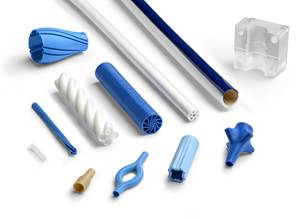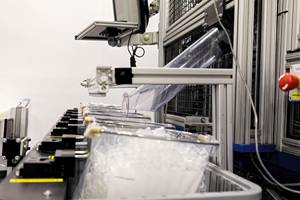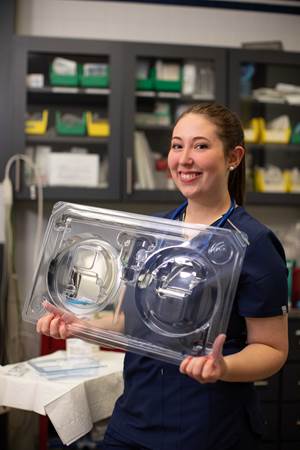MRPC Takes ‘Holistic’ Approach To Scientific Molding
Last year this family-owned molder made a major commitment to Scientific Molding by starting a training process involving all employees.
“We develop a process, not just mold a part.” In one sentence, Jeff Randall encapsulates the philosophy of Scientific Molding at MRPC in Butler, Wis., where he is v.p. of engineering. “A lot of people can squirt plastic into a mold. But to produce a quality part, we need to understand more about the job from every angle.” It adds up to what Randall and Brunson Parish, senior process engineer, like to call a “holistic approach” to Scientific Molding. “It starts at the onset of design with concern for manufacturability, followed by tool design, material selection, process development, and machine validation for production capability and control.” Over the past year, MRPC made a major commitment to Scientific Molding by starting an ongoing process of training and converting all its employees to this philosophy.
Founded in 1921 as Molded Rubber and Plastic Corp., MRPC remains a family-owned business focused on medical clean-room molding and assembly, specializing in liquid silicone rubber (LSR), two-material molding, implantable components, and micromolding. The company has two facilities—the 100,000 ft2 Butler plant with 120 employees, and the former ETI Inc. plant in Largo, Fla. (acquired in 2012), with 10,000 ft2 and 20 employees. Together they have 28 injection presses from 5 to 250 tons, 17 of them for LSR, as well as 34 rubber transfer presses. Company revenues are about $20 million.
Scientific Molding is a philosophy and a method—or bundle of methods—for ensuring consistent processing and part quality. It is the opposite of “black art.” Scientific Molding can be taught, and is taught by a number of professional training consultants and organizations.
Before coming to MRPC, both Randall and Parish had formal training in Scientific Molding from several prominent trainers, John Bozzelli, RJG Inc., Traverse City, Mich., Mike Sepe, and John Klees (now retired). When Parish received his training in 2000, he said, “That’s when the lightbulb went on for me. I saw that it’s a business-changing method that crosses over all manufacturing disciplines—engineering, molding, and quality.”
When Randall brought Parish over to MRPC three years ago, the firm “did not have a formal approach to Scientific Molding, though it used some of its principles,” Parish said. But MRPC president Greg Riemer “recognized that in order for us to be at the top of our game, we had to use—and really believe in—the best practices and best technology possible.”
Recalls Randall, “The first step was to help others appreciate what Scientific Molding has to offer, how it makes everyone’s lives so much easier. A lot of our people had heard of it but didn’t really understand it. So Brunson applied Scientific Molding to a couple of problematic jobs, achieved some successes there, and that made everyone hungry for more.”
Last year, Parish led training classes for 34 key people in Butler—tooling, process, and quality engineers; project leaders; supervisors; setup technicians; lead operators; and material handlers. In a dozen 2-hr sessions, he taught them the fundamental approach of understanding processing “from the plastic’s point of view.”
“We trained a lot of people who may never touch the controls of a molding machine,” says Randall, “but it gives everyone a common baseline, so we all speak the same language. The effect is that we have people now who will pull a mold drawing and question the water layout, gating, and runner sizes—things they never would have done before. Quality engineers, who usually are concerned with how to measure a part after it’s molded, are now asking about the process: ‘This is a critical part feature, so what are we doing to optimize mold-temperature uniformity in that area?’” The next step will be to transfer that knowledge from the core group of seasoned veterans to the rest of the employees at MRPC.
Summarizing the benefits of Scientific Molding for MRPC, Parish says, “Having a documented process results in scrap reduction, faster startups, more repeatable setups, and better troubleshooting. It makes you less susceptible to variations in part quality due to material variations and ambient temperature and humidity. We gain better understanding of our equipment—press responsiveness, dryer efficiency, and mold-cooling efficiency.”
Adds Randall, “Developing a robust process at the front end of a program takes a little more time, but you avoid wasting time later on with trial-and-error, knob-turning, reactive approaches to molding problems. It makes you a more confident molder and makes your customers much more comfortable.” In the medical field, he says, Scientific Molding is becoming a requirement for some customers.
Related Content
Artificial Intelligence Enables Smarter Sourcing
Westfall Technik has adopted Arkestro’s predictive procurement software to wring savings and more reliable deliveries from a historically challenging supply chain.
Read MoreDuPont Buys Medical Product Manufacturer Spectrum Plastics
Purchase price of $1.75 billion for leading supplier of extruded, molded, and 3D printed medical components.
Read MoreAs Currier Grows in Medical Consumables, Blow Molding Is Its ‘Foot in the Door’
Currier Plastics has added substantial capacity recently in both injection and blow molding for medical/pharmaceutical products, including several machines to occupy a new, large clean room.
Read MoreCollaboration will bring Recycled Plastic to Medical Device Packaging
Agreement between Eastman and Ethicon will put copolyester derived from recycled materials in sterile barrier applications.
Read MoreRead Next
Lead the Conversation, Change the Conversation
Coverage of single-use plastics can be both misleading and demoralizing. Here are 10 tips for changing the perception of the plastics industry at your company and in your community.
Read MoreProcessor Turns to AI to Help Keep Machines Humming
At captive processor McConkey, a new generation of artificial intelligence models, highlighted by ChatGPT, is helping it wade through the shortage of skilled labor and keep its production lines churning out good parts.
Read MoreWhy (and What) You Need to Dry
Other than polyolefins, almost every other polymer exhibits some level of polarity and therefore can absorb a certain amount of moisture from the atmosphere. Here’s a look at some of these materials, and what needs to be done to dry them.
Read More


























